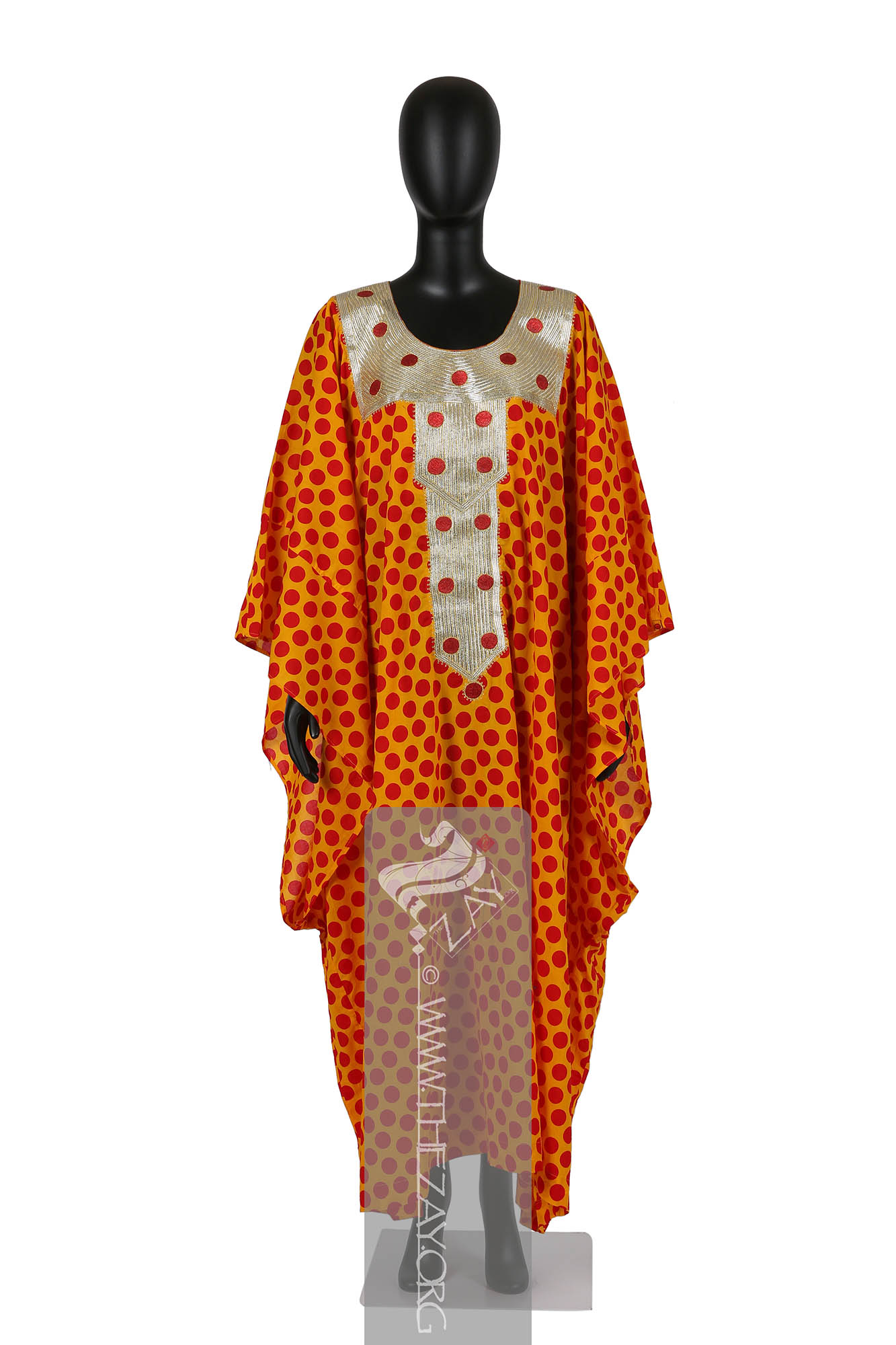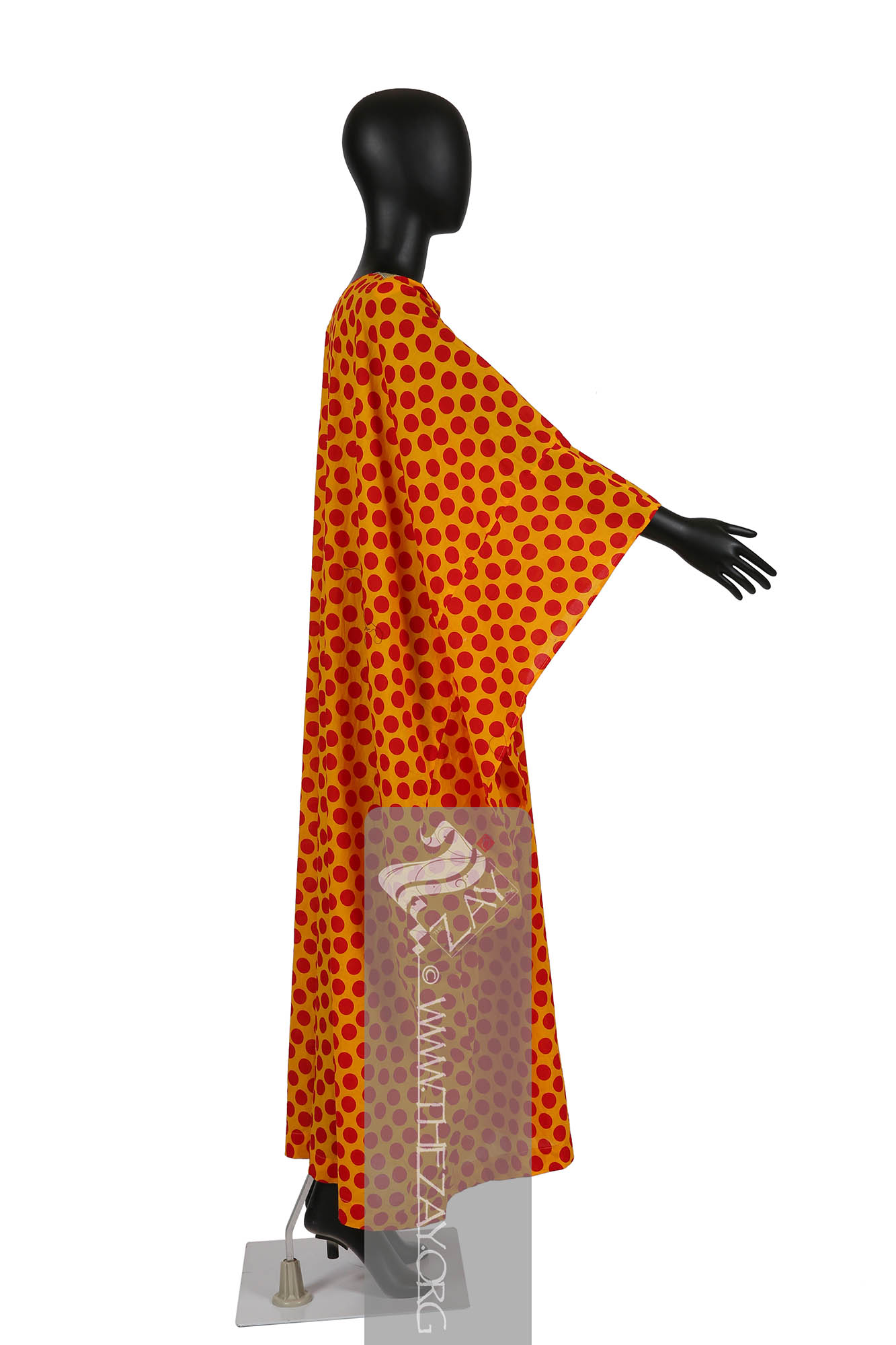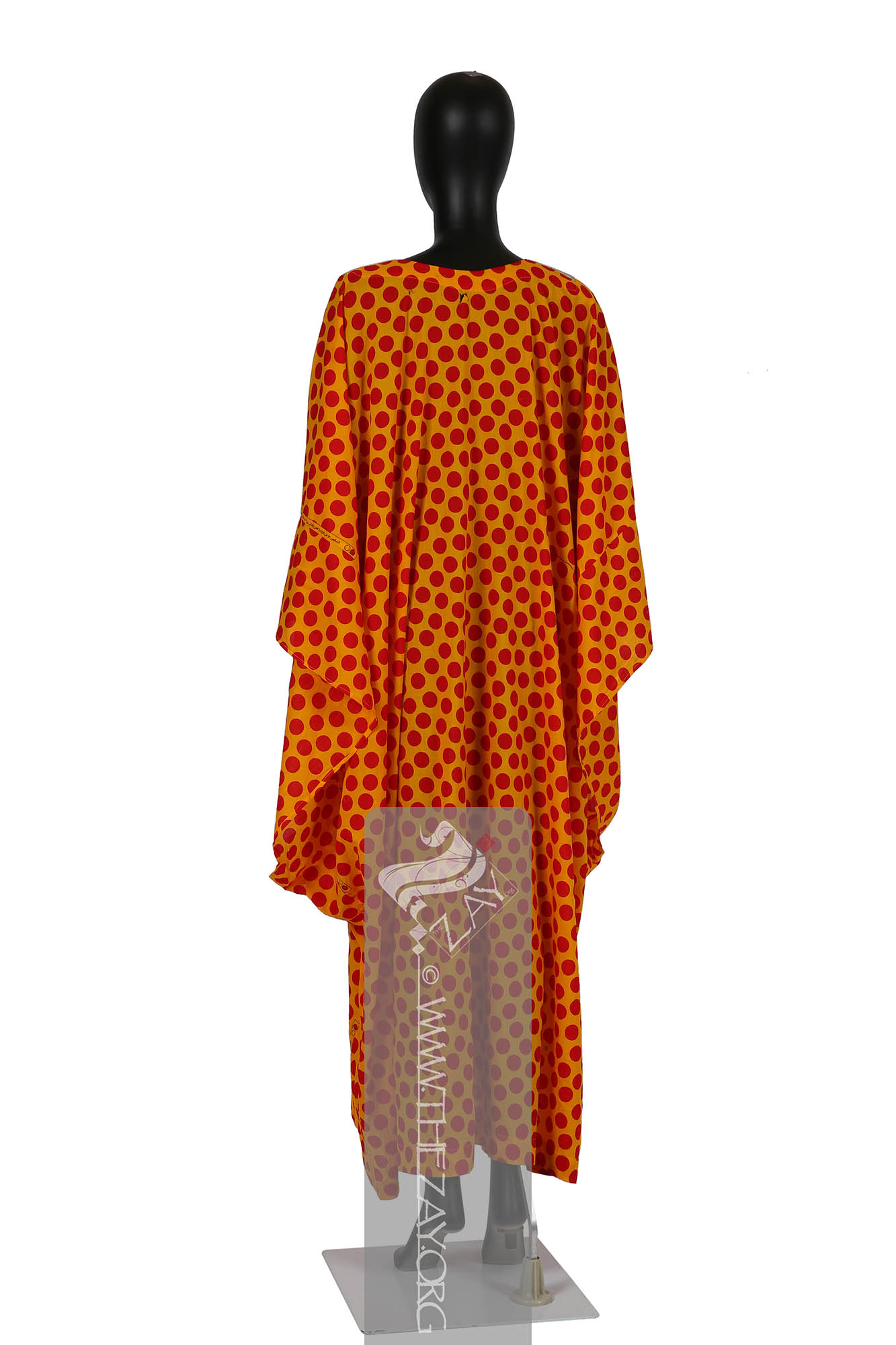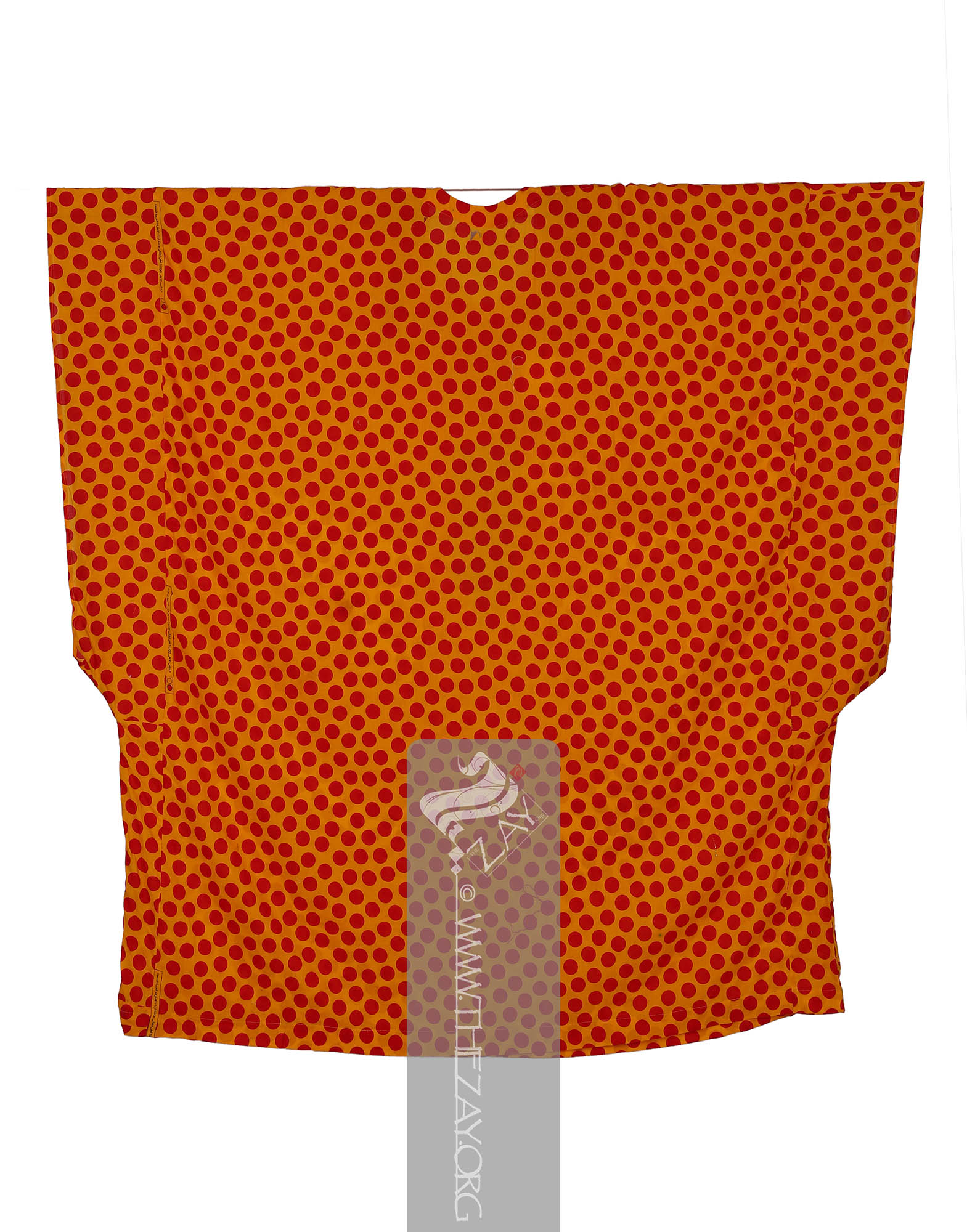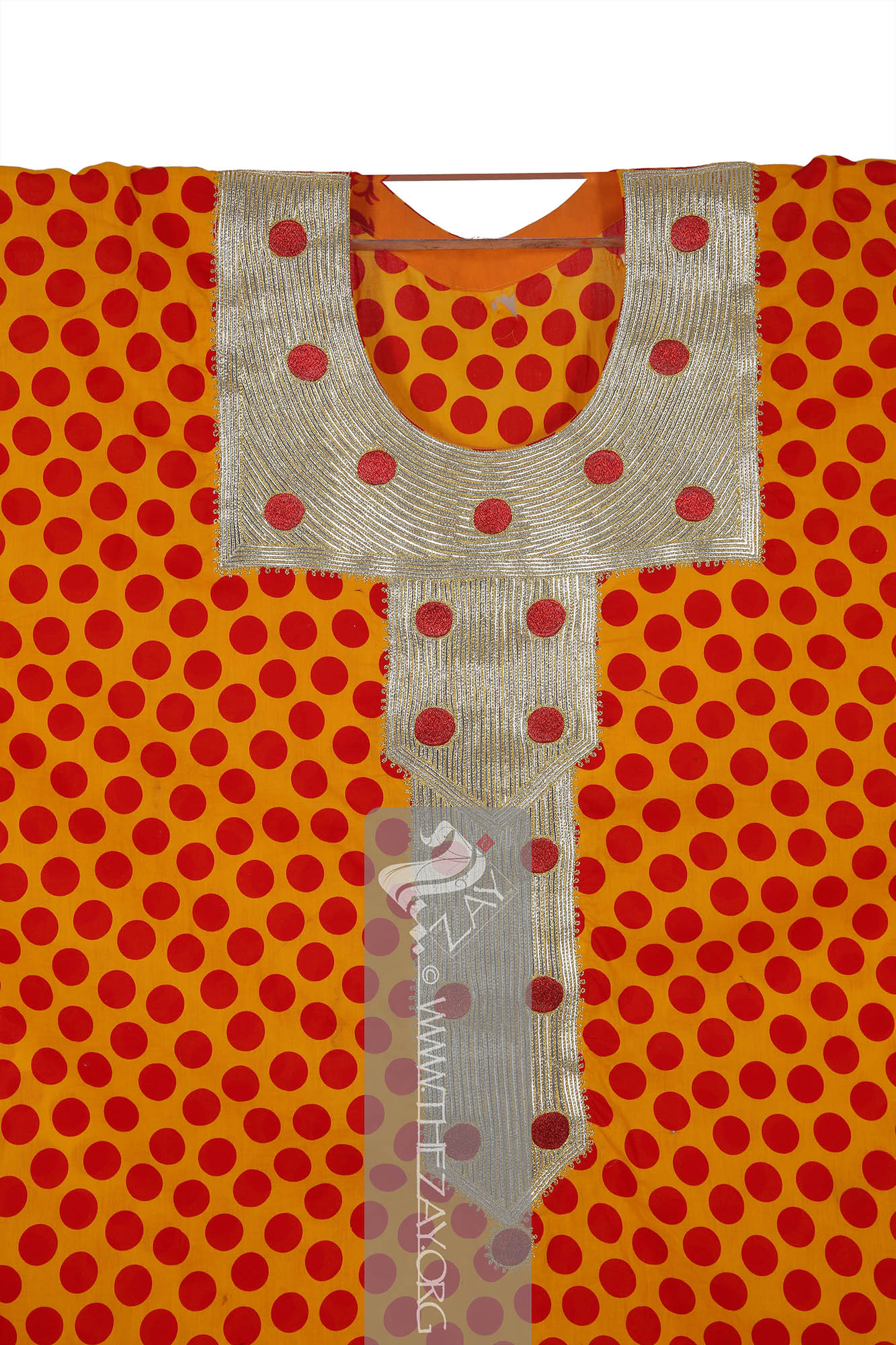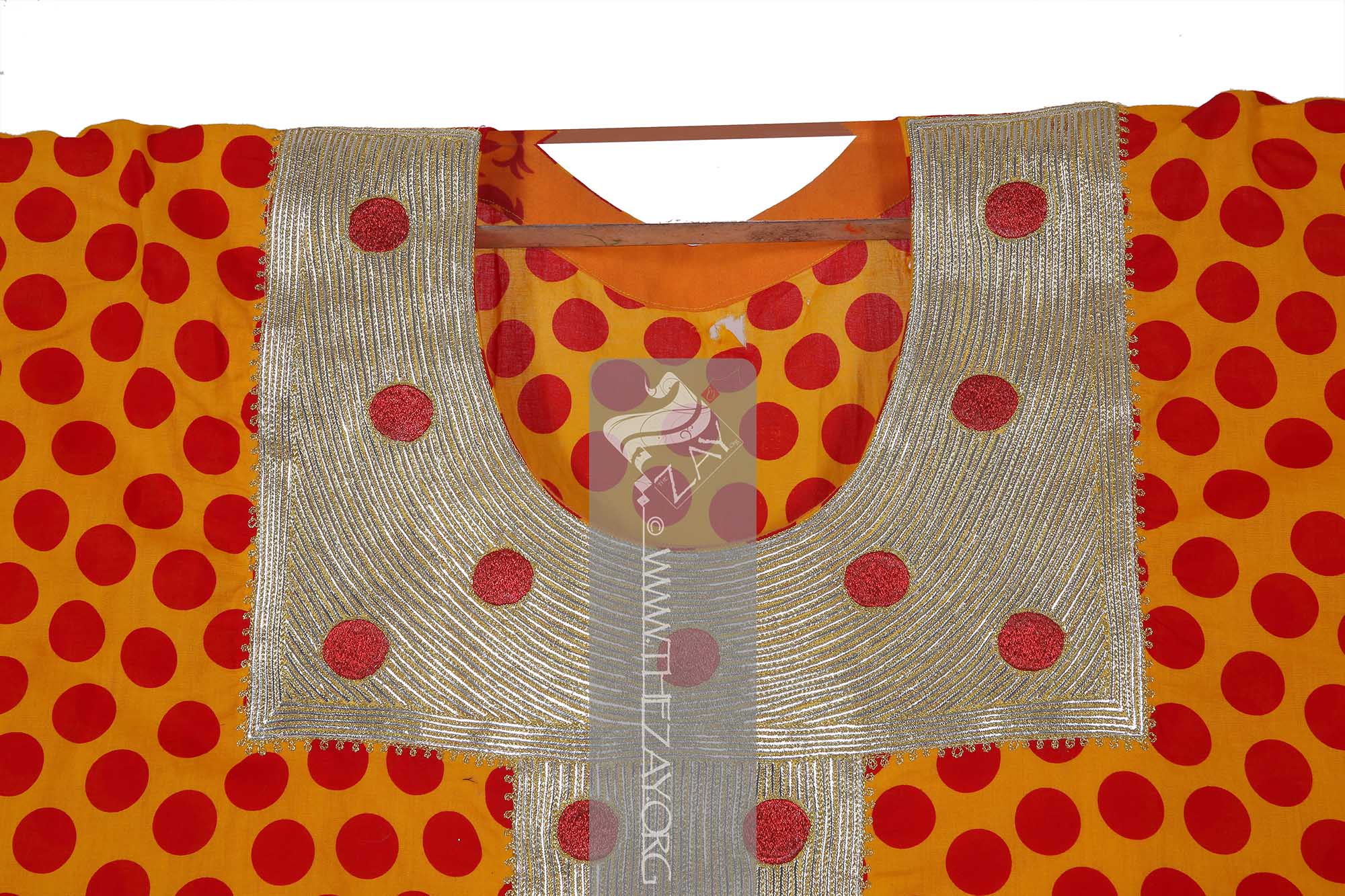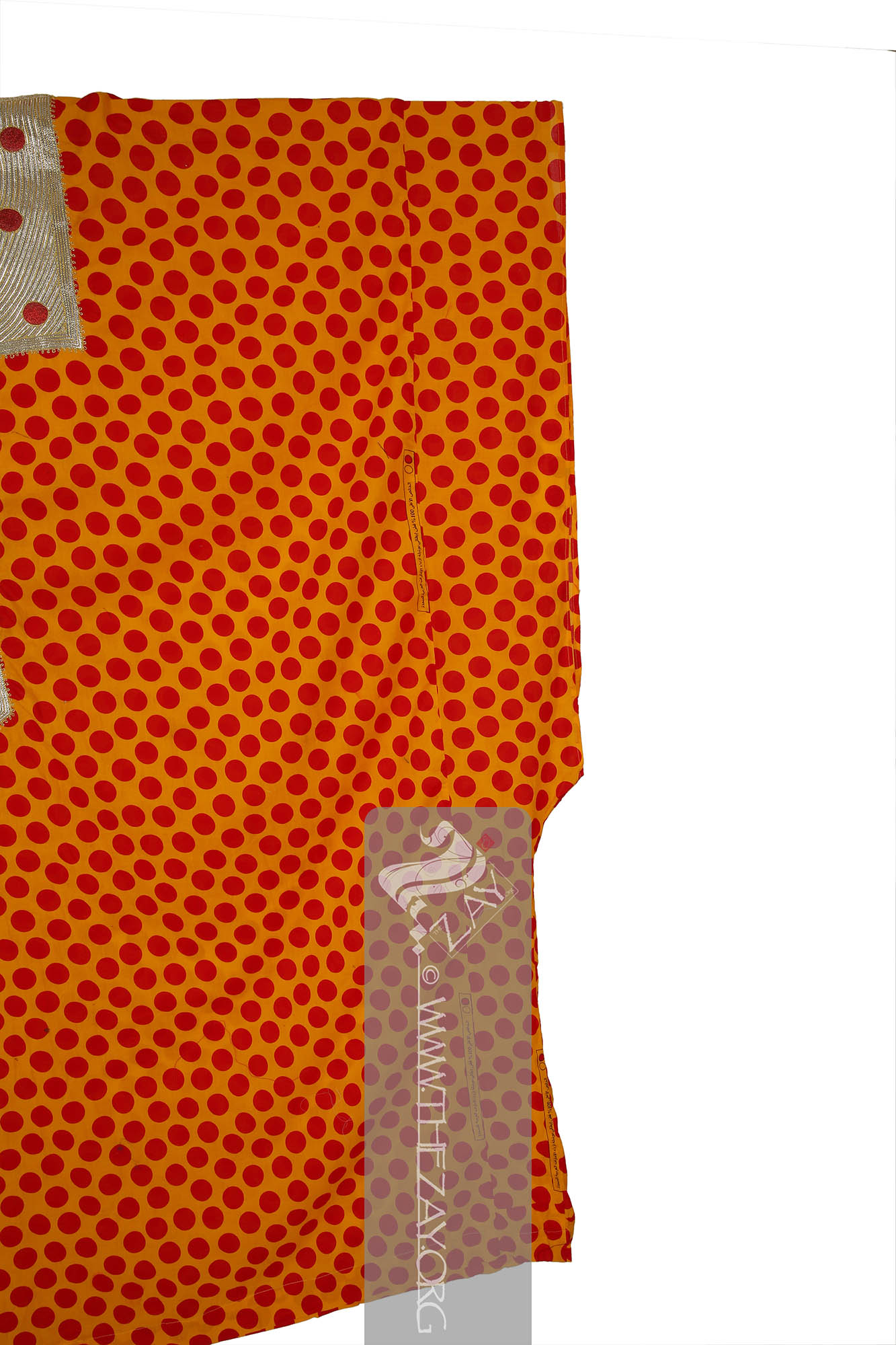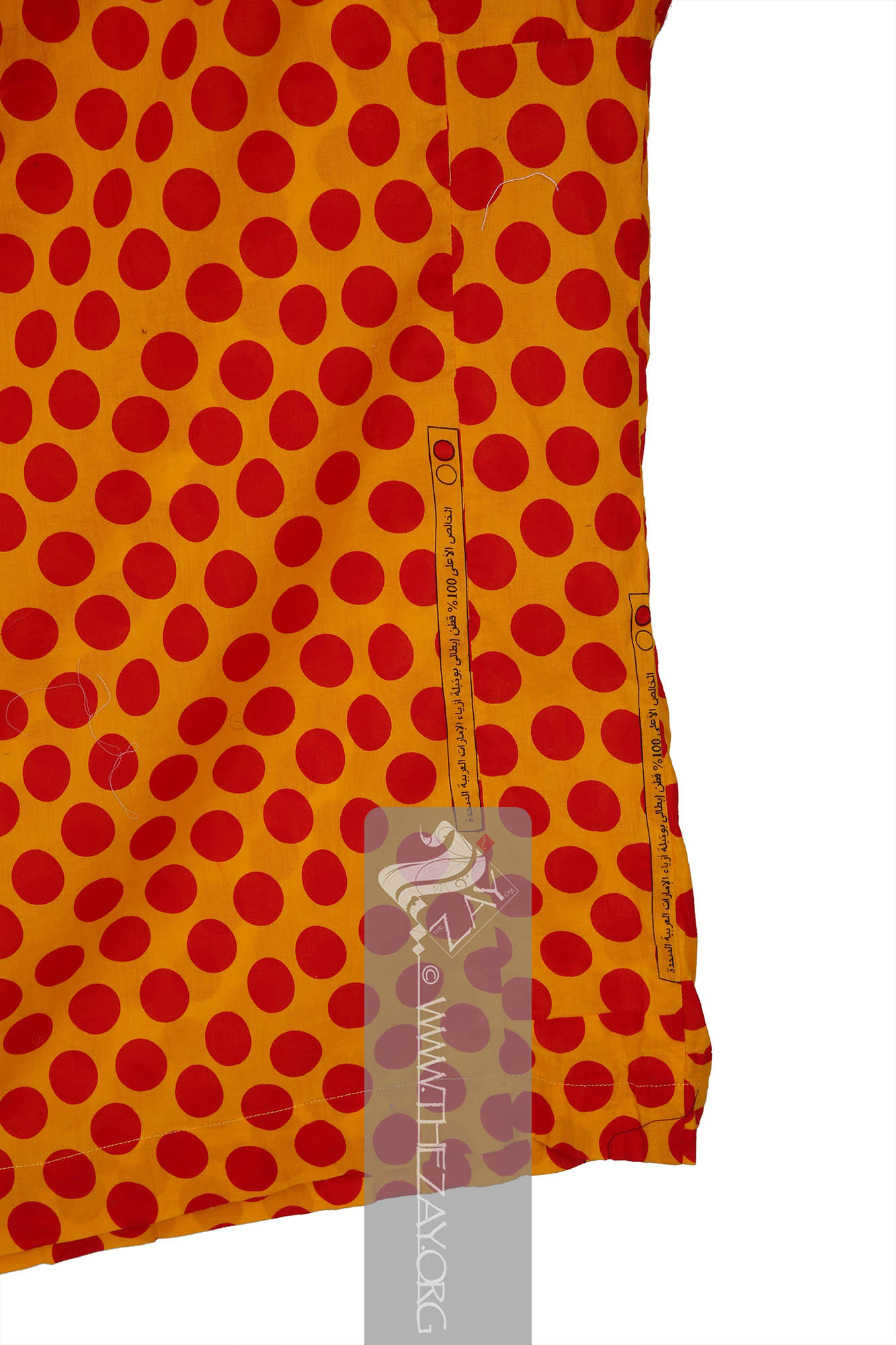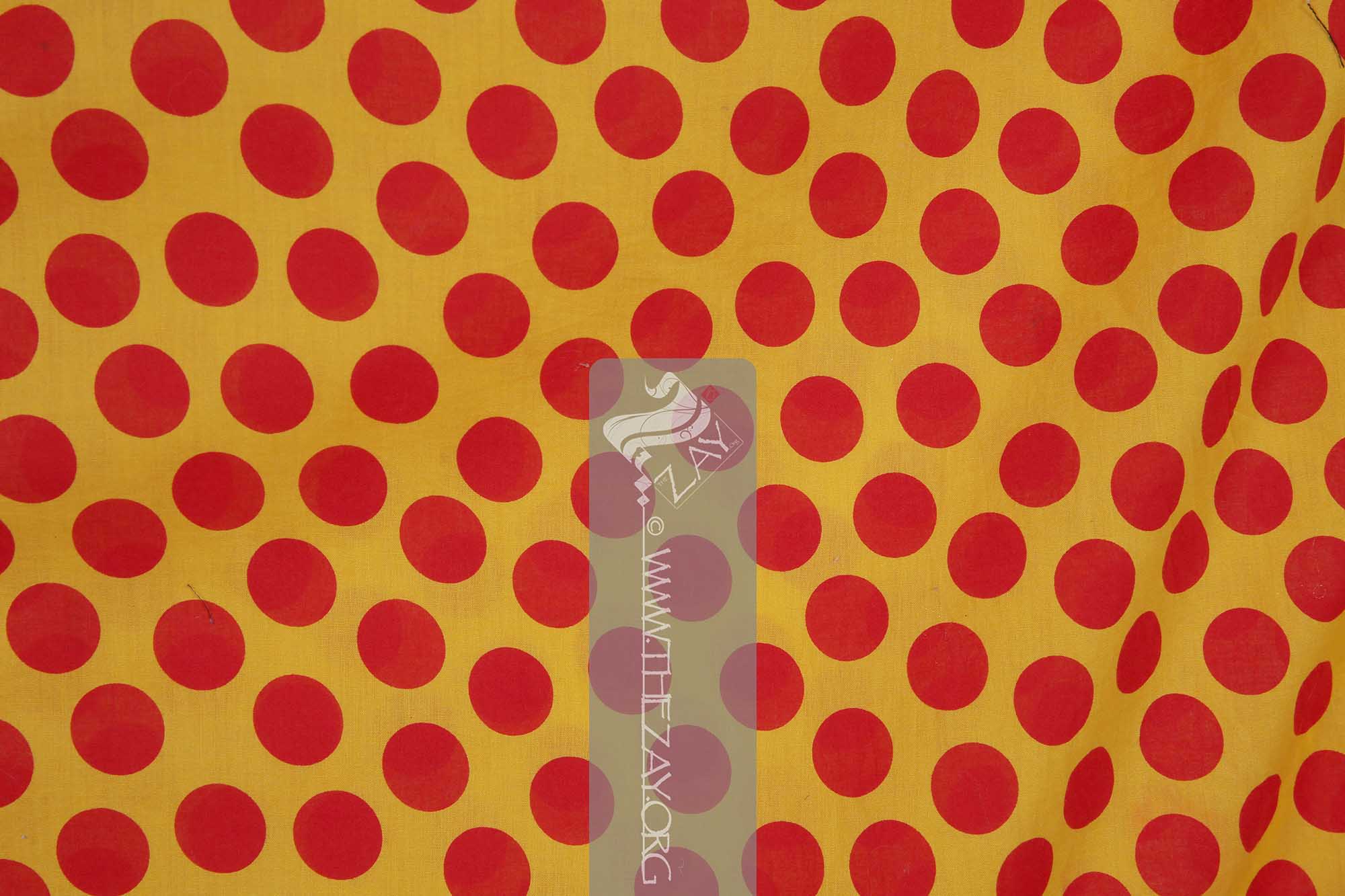Object History Dr. Reem Tariq
Ṭariq: (Arabic; Synonym: tulle_bi_talli; talli; badla; khus_dozi ), series of small metal knots made on a woven net ground as embellishment. The term is commonly used in the Levant Arab region specifically in Lebanon.
el Mutwalli
Dr. Reem Tariq
Ṭariq: (Arabic; Synonym: tulle_bi_talli; talli; badla; khus_dozi ), series of small metal knots made on a woven net ground as embellishment. The term is commonly used in the Levant Arab region specifically in Lebanon.
el Mutwallī: Founder (CEO) of the Zay
Zay: (Arabic: costume, Pl. azyaā’), a set of clothes in a style typical of a particular country or historical period. Initiative, a public figure, speaker and author. An expert curator and consultant in Islamic art and architecture, interior design, historic costume, and UAE heritage. purchased this article of dress in 1993 from Fatimah Al Mghani who had originally sourced it from Khadijah Khalaf Al Nasa in Ajman.
Fatimah Al Mghani is a social researcher and folklore expert, she is also a friend and fellow colleague of Dr. Reem, a supporter of The
Zay
Zay: (Arabic: costume, Pl. azyaā’), a set of clothes in a style typical of a particular country or historical period. Initiative, and a valuable reference in UAE cultural heritage.
Khadijah Khalaf Al Nasaj was born in the late 1940s, from the Emirate of Ajman. A housewife, like many of her peers, she never acquired any formal schooling. She married her paternal cousin at the age of 14 and bore 4 daughters and 3 sons, who all went on to attain university degrees.
Object Features Prior to the 1980s, it was common to employ contrasting colours and techniques within the components of traditional dress. Women used to wear an overgarment (
thawb
Thawb: (Arabic: thawb, Pl. Athwāb/thībān), can be pronounced thobe
Thobe: (Arabic: thawb, Pl. Athwāb/thībān), can be pronounced thawb or tobe
Tobe: (Arabic: thawb, Pl. Athwāb/thībān), can be pronounced thawb or thobe based on locale. The standard Arabic word for ‘fabric’ or ‘garment’. It can refer to a qamīs-like tunic worn by men and women in the Arabian Peninsula, Iraq, the southern and south-western ports and islands of Iran, and some countries in East and West Africa. More specifically, it can refer to the square-shaped Bedouin overgarment worn by women. based on locale. The standard Arabic word for ‘fabric’ or ‘garment’. It can also refer to a qamīs-like tunic worn by men and women in the Arabian Peninsula, Iraq, the southern and south-western ports and islands of Iran, and some countries in East and West Africa. More specifically, it can refer to the square-shaped Bedouin overgarment worn by women. or tobe
Tobe: (Arabic: thawb, Pl. Athwāb/thībān), can be pronounced thawb or thobe based on locale. The standard Arabic word for ‘fabric’ or ‘garment’. It can refer to a qamīs-like tunic worn by men and women in the Arabian Peninsula, Iraq, the southern and south-western ports and islands of Iran, and some countries in East and West Africa. More specifically, it can refer to the square-shaped Bedouin overgarment worn by women. based on locale. The standard Arabic word for ‘fabric’ or ‘garment’. It can also refer to a qamīs-like tunic worn by men and women in the Arabian Peninsula, Iraq, the southern and south-western ports and islands of Iran, and some countries in East and West Africa. More specifically, it can refer to the square-shaped Bedouin overgarment worn by women in the Arabian Gulf region. ) that contrasted with their tunic dress (
kandurah
Kandūrah: (Arabic: qandūrah, pl. kanādīr, synonyms: ghandurah
Ghandūrah: (Arabic, pl. qanādīr, synonyms: qandurah, darā’ah, dishdāshah, jalābah, jallābīyah, qaftan, mqta’, thawb or tobe), a loose, short or long-sleeved, shirt like (qamis
Qamīṣ: (Possibly late Latin: Camisia – Linen Undergarment; Synonym: Kamiz), a traditional loose fitting long tunic or shirt worn by both men and women in South and Central Asia and the Arab world. Typically extending below the waist it is usually paired with a pair of trousers.
) tunic with frontal neckline opening, worn by both sexes. Each Arab region has a different term for what is essentially a similar garment with various small differences., qandurah
Qandūrah: (Arabic, pl. qanādīr, synonyms: ghandurah
Ghandūrah: (Arabic, pl. qanādīr, synonyms: qandurah, darā’ah, dishdāshah, jalābah, jallābīyah, qaftan, mqta’, thawb or tobe), a loose, short or long-sleeved, shirt like (qamis
Qamīṣ: (Possibly late Latin: Camisia – Linen Undergarment; Synonym: Kamiz), a traditional loose fitting long tunic or shirt worn by both men and women in South and Central Asia and the Arab world. Typically extending below the waist it is usually paired with a pair of trousers.
) tunic with frontal neckline opening, worn by both sexes. Each Arab region has a different term for what is essentially a similar garment with various small differences., darā’ah, dishdāshah, jalābah, jallābīyah, qaftan, mqta’, thawb or tobe
Tobe: (Arabic: thawb, Pl. Athwāb/thībān), can be pronounced thawb or thobe based on locale. The standard Arabic word for ‘fabric’ or ‘garment’. It can refer to a qamīs-like tunic worn by men and women in the Arabian Peninsula, Iraq, the southern and south-western ports and islands of Iran, and some countries in East and West Africa. More specifically, it can refer to the square-shaped Bedouin overgarment worn by women. ), a loose, short or long-sleeved, shirt like (qamis
Qamīṣ: (Possibly late Latin: Camisia – Linen Undergarment; Synonym: Kamiz), a traditional loose fitting long tunic or shirt worn by both men and women in South and Central Asia and the Arab world. Typically extending below the waist it is usually paired with a pair of trousers.
) tunic with frontal neckline opening, worn by both sexes. Each Arab region has a different term for what is essentially a similar garment with various small differences. , dra’ah, dishdāshah, jallābīyah, jalābah, jillābīyah, qaftan, mqta’, thawb or tobe
Tobe: (Arabic: thawb, Pl. Athwāb/thībān), can be pronounced thawb or thobe based on locale. The standard Arabic word for ‘fabric’ or ‘garment’. It can refer to a qamīs-like tunic worn by men and women in the Arabian Peninsula, Iraq, the southern and south-western ports and islands of Iran, and some countries in East and West Africa. More specifically, it can refer to the square-shaped Bedouin overgarment worn by women. ) loose, short or long sleeved, shirt like (qamis
Qamīṣ: (Possibly late Latin: Camisia – Linen Undergarment; Synonym: Kamiz), a traditional loose fitting long tunic or shirt worn by both men and women in South and Central Asia and the Arab world. Typically extending below the waist it is usually paired with a pair of trousers.
) tunic with frontal neckline opening, worn by both sexes. Each Arab region has a different term for what is essentially a similar garment with various small differences.). This later evolved into a matching set known as (
thawb_wa_kandurah
Thawb_wa_kandūrah: (colloquial, UAE), an elaborate form of the traditional overgarment (thawb
Thawb: (Arabic: thawb, Pl. Athwāb/thībān), can be pronounced thobe
Thobe: (Arabic: thawb, Pl. Athwāb/thībān), can be pronounced thawb or tobe
Tobe: (Arabic: thawb, Pl. Athwāb/thībān), can be pronounced thawb or thobe based on locale. The standard Arabic word for ‘fabric’ or ‘garment’. It can refer to a qamīs-like tunic worn by men and women in the Arabian Peninsula, Iraq, the southern and south-western ports and islands of Iran, and some countries in East and West Africa. More specifically, it can refer to the square-shaped Bedouin overgarment worn by women. based on locale. The standard Arabic word for ‘fabric’ or ‘garment’. It can also refer to a qamīs-like tunic worn by men and women in the Arabian Peninsula, Iraq, the southern and south-western ports and islands of Iran, and some countries in East and West Africa. More specifically, it can refer to the square-shaped Bedouin overgarment worn by women. or tobe
Tobe: (Arabic: thawb, Pl. Athwāb/thībān), can be pronounced thawb or thobe based on locale. The standard Arabic word for ‘fabric’ or ‘garment’. It can refer to a qamīs-like tunic worn by men and women in the Arabian Peninsula, Iraq, the southern and south-western ports and islands of Iran, and some countries in East and West Africa. More specifically, it can refer to the square-shaped Bedouin overgarment worn by women. based on locale. The standard Arabic word for ‘fabric’ or ‘garment’. It can also refer to a qamīs-like tunic worn by men and women in the Arabian Peninsula, Iraq, the southern and south-western ports and islands of Iran, and some countries in East and West Africa. More specifically, it can refer to the square-shaped Bedouin overgarment worn by women in the Arabian Gulf region. ) and tunic (kandūrah) ensemble, that evolved post-1980s where the two garments became matched as a set.), in which the two garments were fabricated from the same or matching materials and colours.
By the late 1990s, the
thawb_wa_kandurah
Thawb_wa_kandūrah: (colloquial, UAE), an elaborate form of the traditional overgarment (thawb
Thawb: (Arabic: thawb, Pl. Athwāb/thībān), can be pronounced thobe
Thobe: (Arabic: thawb, Pl. Athwāb/thībān), can be pronounced thawb or tobe
Tobe: (Arabic: thawb, Pl. Athwāb/thībān), can be pronounced thawb or thobe based on locale. The standard Arabic word for ‘fabric’ or ‘garment’. It can refer to a qamīs-like tunic worn by men and women in the Arabian Peninsula, Iraq, the southern and south-western ports and islands of Iran, and some countries in East and West Africa. More specifically, it can refer to the square-shaped Bedouin overgarment worn by women. based on locale. The standard Arabic word for ‘fabric’ or ‘garment’. It can also refer to a qamīs-like tunic worn by men and women in the Arabian Peninsula, Iraq, the southern and south-western ports and islands of Iran, and some countries in East and West Africa. More specifically, it can refer to the square-shaped Bedouin overgarment worn by women. or tobe
Tobe: (Arabic: thawb, Pl. Athwāb/thībān), can be pronounced thawb or thobe based on locale. The standard Arabic word for ‘fabric’ or ‘garment’. It can refer to a qamīs-like tunic worn by men and women in the Arabian Peninsula, Iraq, the southern and south-western ports and islands of Iran, and some countries in East and West Africa. More specifically, it can refer to the square-shaped Bedouin overgarment worn by women. based on locale. The standard Arabic word for ‘fabric’ or ‘garment’. It can also refer to a qamīs-like tunic worn by men and women in the Arabian Peninsula, Iraq, the southern and south-western ports and islands of Iran, and some countries in East and West Africa. More specifically, it can refer to the square-shaped Bedouin overgarment worn by women in the Arabian Gulf region. ) and tunic (kandūrah) ensemble, that evolved post-1980s where the two garments became matched as a set. evolved further, as these two separate articles of dress were merged into one, becoming attached at the neckline, using the inner tunic as lining and creating a combination overgarment tunic (
thawb_kandurah
Thawb_kandūrah: (colloquial, UAE), post-1990s the (Thawb_wa_kandūrah) ensemble of the eighties evolved where the overgarment (thawb) and tunic (kandūrah) became united at the neckline creating one outfit and inner tunic receding to act as lining.).
This
thawb
Thawb: (Arabic: thawb, Pl. Athwāb/thībān), can be pronounced thobe
Thobe: (Arabic: thawb, Pl. Athwāb/thībān), can be pronounced thawb or tobe
Tobe: (Arabic: thawb, Pl. Athwāb/thībān), can be pronounced thawb or thobe based on locale. The standard Arabic word for ‘fabric’ or ‘garment’. It can refer to a qamīs-like tunic worn by men and women in the Arabian Peninsula, Iraq, the southern and south-western ports and islands of Iran, and some countries in East and West Africa. More specifically, it can refer to the square-shaped Bedouin overgarment worn by women. based on locale. The standard Arabic word for ‘fabric’ or ‘garment’. It can also refer to a qamīs-like tunic worn by men and women in the Arabian Peninsula, Iraq, the southern and south-western ports and islands of Iran, and some countries in East and West Africa. More specifically, it can refer to the square-shaped Bedouin overgarment worn by women. or tobe
Tobe: (Arabic: thawb, Pl. Athwāb/thībān), can be pronounced thawb or thobe based on locale. The standard Arabic word for ‘fabric’ or ‘garment’. It can refer to a qamīs-like tunic worn by men and women in the Arabian Peninsula, Iraq, the southern and south-western ports and islands of Iran, and some countries in East and West Africa. More specifically, it can refer to the square-shaped Bedouin overgarment worn by women. based on locale. The standard Arabic word for ‘fabric’ or ‘garment’. It can also refer to a qamīs-like tunic worn by men and women in the Arabian Peninsula, Iraq, the southern and south-western ports and islands of Iran, and some countries in East and West Africa. More specifically, it can refer to the square-shaped Bedouin overgarment worn by women in the Arabian Gulf region. is simply constructed, made out of a cut length of bright orange cotton fabric, printed in 2 cm diameter red coloured polka dots (
bu_tilah
Bū_tīlah: (Arabic, bū: diminutive of abu: father, tīlah: glass marbles), colloquially in UAE refers to printed or embroidered glass-marble shape and size circular or polka dot motifs.) also known as (
bu_baysah
Bū_baysah (Indian: Paisa: coin), UAE colloquial reference to polka dots in the shape and size of the Indian Paisa coin an earlier denomination of the Indian Rupee.). It is folded with an opening created at the center of the fold for the neckline (
halj
Ḥalj: (Arabic: ḥalq: mouth, pl: ḥlūj,). Colloquially, the term refers to the neckline opening. The letter (qāf) is turned (jīm) in many Arab dialects.). The sleeves (
jinan
Jinān: (Colloquial Arab Gulf, synonym: akmām, kmūm, chmūm), wide sleeve panels on overgarments (athwāb). ) are simply assembled out of two panels added to the central
bodice
Bodice: (English: body), or bodices the plural form of body, it is the close-fitting garment meant to cover the body above the waist or the torso. However, it was not until the 17th century that the term became synonymous to women’s undergarment. panel (
bdinah
Bdinah: (Arabic: bdan
Bdan: (Arabic: bdan: body, synonym: bdinah), generally refers to the central body panel on garments in most Arab Gulf dialect. : body, synonym: bdan
Bdan: (Arabic: bdan: body, synonym: bdinah), generally refers to the central body panel on garments in most Arab Gulf dialect. ), generally refers to the central body panel on garments in most Arab Gulf dialect. ).
The neckline and central axis (
bidhah
Bidḥah: (Arabic: qata'a or shaqqa: to cut or split). In Emirati dialect, the term refers to the chest area of a garment generally decorated in embroidery or other embellishments.) are densely machine embroidered (
khwar
Khwār: (colloquial, UAE) refers to machine embroidery in silk thread (brīsam), gold metallic coil (zarī), or pure silver coil (khwār_tūlah). It typically decorates the neckline opening (ḥalj) and sleeve cuffs of the tunic (kandūrah), the chest (bidḥah) on the overgarment (thawb) or ankle-cuffs of underpants (sarwāl). It is also known as (mkhawar
Mkhawar: (colloquial, UAE) refers to machine embroidery in silk thread (brīsam), gold metallic coil (zarī), or pure silver coil (khwār_tūlah). It typically decorates the neckline opening (ḥalj) and sleeve cuffs of the tunic (kandūrah), the chest (bidḥah) on the overgarment (thawb) or ankle-cuffs of underpants (sarwāl). It is also known as (khwār), (takhwīr), (dag), or (ḍarb).), (takhwīr), (dag), or (ḍarb). dag
daq: to hit or beat). Generally, it means ‘made by’ or ‘made in’, as in ‘made in India’ (dag_al Hind). Also, a general term for embroidery or adornment as in (dag_talli) or silver embellished (dag_faḍah). Colloquially, the letter (Qāf) is pronounced (ga). ) in lines of metallic silver thread (
zari
Zarī: (Persian two-syllables: zar: gold & dozi: embellishment), complex embroidery technique that uses metal alloy on silk, satin, or velvet, and may include pearls, beads, and precious stones. Colloquially in the Arab gulf region, the term (zarī) is loosely applied to any gilded thread, embellishment or gilded brocade fabric. Originated in ancient Persia it has been used extensively in Indian and Middle Eastern textiles for centuries. ), interspersed with polka dots (
bu_tilah
Bū_tīlah: (Arabic, bū: diminutive of abu: father, tīlah: glass marbles), colloquially in UAE refers to printed or embroidered glass-marble shape and size circular or polka dot motifs. /
bu_baysah
Bū_baysah (Indian: Paisa: coin), UAE colloquial reference to polka dots in the shape and size of the Indian Paisa coin an earlier denomination of the Indian Rupee.) in red silk (
brisam
Brīsam: (Persian: Aabrēšam, Syriac: Aprišum
‘Um: (Arabic: mother), a sign of respect or formality, women are not addressed by their own names, rather as mother of, then adding the name of the eldest son as in Um Mohammed. Also can mean: with, for example (‘um mishakhiṣ) meaning with gold embellishment., English: prism). Generally, refers to the finest form of silk thread. Also pronounced (ibrīsam).) thread, mimicking the exact print found on the fabric. Thus, referred to colloquially as (tab‘ah).




